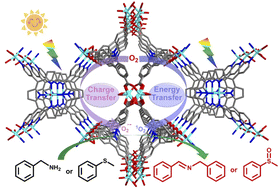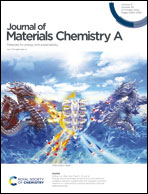Effective charge and energy transfers within a metal–organic framework for efficient photocatalytic oxidation of amines and sulfides†
Abstract
The photocatalytic reaction is regarded as an efficient and sustainable strategy to convert solar energy into chemical energy. In the work, a novel metal–organic framework Zn5(TPyP)(BCTC)2(H2O)3 (denoted as CCNU-16, H2TPyP = 5,10,15,20-tetra(4-pyridyl)-21H,23H-porphine, H4BCTC = [9,9′-bicarbazole]-3,3′,6,6′-tetracarboxylic acid) was successfully synthesized from porphyrin- and carbazole-based organic linkers, which exhibits excellent visible-light-responsive characteristic. CCNU-16 was further applied toward photo-induced aerobic oxidation of amines and sulfides in air under visible light illumination and ambient conditions. Outstandingly, the turnover frequency (TOF) of the photocatalytic oxidative coupling of benzylamine over CCNU-16 is at the high end among MOF-based photocatalysts, so far, even under green and mild conditions. The excellent photocatalytic activity is attributed to superoxide radical anion (O2˙−) and singlet oxygen (1O2) generated by the synergistic charge transfer (CT) and energy transfer (ET) processes, which provide a reasonable and efficient method for the photocatalytic oxidation of organic transformations.



 Please wait while we load your content...
Please wait while we load your content...